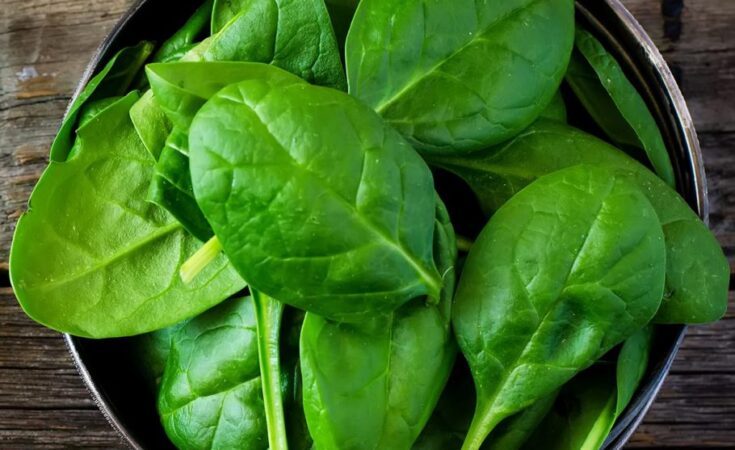Table Of Contents:
As a child, you must have watched ‘Popeye, The Sailor Man’.. What gives Popeye the energy to fight against the evil Brutus or anyone else for that matter? Spinach, of course.
Indeed, spinach has a legendary reputation for being a rich source of vitamin c, which helps in iron absorption. It also has calcium and potassium in abundance, with the latter outnumbering all the other minerals present in the vegetable.
MomJunction helps you understand the importance of spinach in your baby’s diet and shares some easy and delicious ways to feed this vegetable.
When Can Babies Eat Spinach?
You must wait till your baby is 12 months old for introducing spinach in his/her diet (1). The leaves are rich in compounds called nitrates, which cannot be digested by the developing digestive system of infants.
Health Benefits Of Spinach For Babies
Spinach is a treasure trove of minerals. Here is why it is the perfect food for your baby:
- Makes bones stronger: Spinach is rich in minerals such as calcium, magnesium, and phosphorus, all of which play a significant role in strengthening bones and aiding in healthy development.
- Good for muscles: Around 100g spinach contains 2.14g of protein, which makes it a good vegetarian source of amino acids and combines well with other high-protein foods such as meats, cottage cheese and legumes.
- Healthy circulatory system: Iron along with protein, helps in proper circulation in the body as this combination of iron and protein helps in building hemoglobin profile . It is perhaps the most well-known benefit of spinach.
- Good for immunity: The multivitamin food has all the major vitamins required for a healthy immune system. In fact, spinach is a rich source of vitamin K (2)
.
- Aids in hydration: Spinach is over 90% water that means it is naturally rich in fluids to keep your baby hydrated.
- Benefits the eyesight: Since spinach is a rich source of beta carotene (vitamin A), it aids in maintaining and improving the eyesight.
- Acts as a natural laxative: Babies who often get constipated may be given spinach as it absorbs water and adds bulk to the stool.
- Can kill intestinal worms: Weekly consumption of spinach ensures the removal of pest and worms that feed off the intestine and often make babies weak and sick.
[ Read: Nutrients To Feed Baby After 6 Months ]
Nutritional Value
Here is the nutritional breakdown of the various nutrients found in 100g spinach.
| Nutrient | Unit Value Per 100 gm |
|---|---|
| Energy | 23 Kcal |
| Carbohydrates | 3.6 g |
| Natural sugars | 0.4 g |
| Fiber | 2.2 g |
| Protein | 2.9 g |
| Fat | 0.4 g |
| Calcium | 99 mg |
| Iron | 2.71 mg |
| Magnesium | 79 mg |
| Phosphorus | 49 mg |
| Potassium | 558 mg |
| Sodium | 79 mg |
| Manganese | 0.897 mg |
| Copper | 0.130 mg |
| Zinc | 0.53 mg |
| Selenium | 1µg |
| Vitamin C | 28 mg |
| Vitamin B1 (Thiamin) | 0.078 mg |
| Vitamin A | 469 µg |
| Vitamin E | 2 mg |
| Vitamin K | 483 µg |
Source: United States Department of Agriculture (3)
How To Select And Store Spinach?
Select:
- Spinach is available throughout the year, either in frozen or fresh form. Buy the fresh ones since the frozen or commercially processed variants tend to have more nitrates (4). Also, buy the vegetable during the season of its availability when the nutrient value is high. Avoid spinach during summer.
- Fresh spinach has ample of green leaves, intact leaf midrib, and feels like a freshly plucked leaf of a plant. Do not buy if the leaf has blemishes, is yellowish, or has holes which were probably made by pests.
- Fold the leaf, and if it wrinkles severely or does not unfold, then it has low water content, indicating it is not fresh.
- The stem of the leaf should be supple and feel pulpy. Such stems break with a snap when bent or twisted.
- Spinach is prone to pesticides contamination (5). Therefore, prefer organic varieties.
Storage:
- Chop the roots, if the vegetable has any since they are extremely fibrous and difficult to cook.
- Wash the spinach thoroughly with water since they are grown close to the ground and may have attached particles of soil.
- Spread and dry the leaves on the kitchen towel or tissue papers. They absorb the moisture, thus reducing the chances of rotting.
- Transfer the vegetable into a plastic container or a vegetable bag. Put some tissue papers along since they will help absorb extra moisture and prevent the leaves from getting soggy. Store it in the refrigerator and use within two days.
Baby spinach is a variety of spinach , which is harvested at a younger plant age. It has tender leaves, and there is no significant nutritional difference between baby spinach and the fully-grown versions. However, baby spinach is predominantly used in salads (6). For your baby’s food, you can choose the conventional fully-grown varieties of spinach.
[ Read: Fiber Rich Foods For Babies ]
How To Cook Spinach For Baby?
There are various ways to cook spinach, but blanching (boiling the water and putting the leaves in the hot water for 15-20 seconds) is the best since it frees the naturally-present oxalic acid from the leaves. The acid may be slightly toxic and may strain the baby’s kidneys (7). For the same reason, you need to strain the water after boiling the spinach.
Amazing Spinach Recipes For Babies
Here are some wonderful baby food spinach recipes to feed in combination with other food items:
1. Spinach puree
The classic spinach baby food recipe works as a health tonic with all the goodness of multiple vitamins and minerals from the leafy vegetable.
You will need:
- 2 cups of chopped fresh spinach
- Finely grated paneer
- 4-5 cups of water
How to:
- Pour the water into a cooking pot or a pressure cooker and transfer the spinach into it. Boil the spinach for five to seven minutes or for the desired time until the leaves turn soft.
- Run the cooked spinach under cold water and transfer to a blender. Add some drinking water and blend the vegetable till the required consistency. Blend it further if you want to prepare spinach soup for your baby.
2. Spinach and carrot puree
Carrots and spinach, both, are rich in vitamin A, which makes this puree an amazing vitamin A booster for the little one. You may also make a thin suji porridge with these vegetables.
You will need:
- 2 cups cubed carrot pieces
- 2 cups chopped fresh spinach
- 4-5 cups of water
How to:
- Boil the spinach separately to prevent oxalic acid from settling on the carrots. If you are using a pressure cooker, you can turn off the flame after two whistles.
- Transfer the vegetables to a sieve and rinse them under running cold or room temperature water.
- Put the vegetables in a blender, add some water, and blend them to the desired consistency.
3. Spinach and banana mash
Banana goes great with spinach since it dulls the slightly bitter flavor of the leaves, making it more palatable to the baby.
You will need:
- 2 cups chopped banana
- 2 cups chopped fresh spinach
- 3-4 cups of water
How to:
- Process the spinach the usual way to make puree. Mash some bananas till there are no solid lumps.
- Mix the mashed banana and the spinach puree with a fork or by lightly blending it with a dull blender blade.
[ Read: Breakfast Recipes For Babies ]
4. Spinach meat puree
Meat is rich in iron and minerals, complimenting it well with spinach.
You will need:
- 1-2 cups boneless chicken
- 2 cups chopped fresh spinach
- 4-5 cups of water
How to:
- Cook the meat and spinach separately till they are tender. Run the spinach under cold water and transfer it to a blender with the boiled meat pieces.
- Add some water to the blender and blend the meat and spinach until there are no hard lumps and they have mixed well. Pour some additional water during the blending to thin the consistency.
5. Spinach chicken soup
If your baby likes soups, then he will surely love this delicious soup made from chicken stock and spinach puree.
You will need:
- 2 cups chopped chicken with bone
- 2 cups chopped fresh spinach
- 6-7 cups of water
- Butter
How to:
- Making chicken stock in a traditional cooking pot can take hours so you can use a pressure cooker to fasten the process. Put the pieces of chicken in the cooker and pour water over them till they are completely submerged. Cook the chicken for five to six whistles.
- Strain the chicken stock using a sieve and put it in a blender.
- Prepare the spinach puree.
- Pour the thin spinach puree into the blender with the chicken stock and blend them till they mix well. Avoid adding plain water to thin the consistency since it may not taste well. Add melted butter to it.
6. Spinach and peas mash
A green delight full of the goodness of proteins and vitamins that are abundant in green peas and spinach.
You will need:
- 2 cups fresh green peas
- 2 cups chopped fresh spinach
- 4-5 cups of water
How to:
- Boil the peas while also cooking the spinach separately. Once cooked, move them into a vegetable sieve and run some cold water on them.
- Put the cooked vegetables in a blender, and blend them coarsely. You can also use a manual pounder.
7. Spinach and potato puree
You can use sweet potato or white potato since both add carbohydrates providing energy to the little one.
You will need:
- 2 cups chopped sweet or white potato
- 2 cups chopped fresh spinach
- 4-5 cups of water
How to:
- Boil the spinach and potatoes separately till they are soft and transfer them to a blender.
- Add some water and blend till the potatoes and spinach have mixed well to form a puree.
[ Read: Paneer Recipes For Babies ]
8. Spinach with lentil
Spinach tastes great with lentils, and you can use any lentil that you feed your baby. For this recipe, we have chosen pigeon pea, which is also known as arhar or toor dal in India.
You will need:
- 1 cup cleaned pigeon peas
- 2 cups chopped fresh spinach
- 4-5 cups of water
How to:
- Wash the lentils with plenty of water before transferring them into a cooking pot or pressure cooker. Do not drain away any excess water since you can use it during the pureeing process.
- Boil the spinach separately and transfer the cooked spinach into a blender with the cooked lentil. Blend them together till they have mixed well. The cooked lentil already has ample water, but you can pour some more to thin the consistency of the preparation.
9. Spinach puree with mashed boiled rice
Rice goes well with spinach puree. Just like bananas, rice can mellow down the somewhat bitter taste of spinach, thanks to its rich carbohydrate content.
You will need:
- 2 cups of rice
- 2 cups chopped fresh spinach
- 4-5 cups of water
How to:
- Cook the rice the usual way by boiling it. Add some extra water during the cooking process to make the rice extra soft.
- Process the spinach the usual way for spinach puree. Make the puree separately.
- Transfer the rice, along with excess water and the spinach puree, into a blender. Blend them coarsely for one to two minutes with a dull blade. Mix them well and ensure that the rice is in small bits so the baby can eat without the risk of a choking hazard.
10. Spinach puree with finger millet flour (ragi)
Finger millet or ragi is rich in minerals such as calcium and iron, which are found in plenty even in spinach, making this puree a superfood!
You will need:
- 2 cups finger millet flour
- 2 cups fresh, chopped spinach
- 4-5 cups of water
How to:
- Boil the millet flour in a cooking pot. Add some more water so that it is easy to blend later. Stir the mixture and simmer the flame once it comes to boil. Cook for three to five minutes while stirring to prevent any lumps.
- Process the spinach to make a puree and transfer it to a blender. Add the millet porridge that you had made separately, to the blender and blend them until they mix well. Add some water if the mix gets too thick.
11. Spinach puree with sago (sabudana)
Sago pearls or sabudana is easy to digest, and when combined with spinach puree, it makes a fantastic spinach baby food.
You will need:
- 2 cups sago pearls
2 cups chopped fresh spinach
4-5 cups of water
How to:
- Boil the sago pearls till they are soft while simultaneously cooking the spinach and then pureeing it.
- Transfer the cooked sago and the excess water into a blender. Add the spinach puree to it and blend it coarsely to break the sago pearls into smaller pieces, which can make eating them easier for the baby.
Aren’t these recipes really easy? You can combine the leafy vegetable with other foods that your baby consumes to make spinach an integral part of the baby’s diet.
Note: Add fat i.e., oil, butter, clarified butter, etc., to the foods to make them calorie dense. You may also some mild spices in order to introduce various flavors.
[ Read: Super Foods For Babies ]
Spinach Baby Food Combinations
Spinach can be combined with food items such as:
- Vegetables: You can combine nearly any vegetable from carrots to beans with spinach depending on the baby’s age and what suits them.
- Grains and lentils: Spinach compounds the nutritional value of grains and lentils making them more beneficial to the little one’s health.
- Meat: Even adults love the combination of meat and greens such as spinach, so why not let your baby enjoy that flavor too.
- Fruits: Spinach goes well with a limited number of fruits such as bananas, apples, and blueberries. Avoid mixing it with juicy and pulpy fruits such as mangoes or strawberries since the leafy vegetable can distort their taste.
Can My Baby Be Allergic To Spinach?
Spinach is one of the most common allergens (8). The oxalic acid in the leaves can be eliminated when you boil them, but the nitrates remain. Intolerance to nitrates can lead to a blood disorder called methemoglobinemia, where the blood is unable to adequately transfuse oxygen to the tissues (9). Start by giving smaller portions of spinach and if you notice that your baby has any reaction, then discontinue it and consult a doctor immediately.
The symptoms of spinach allergy and methemoglobinemia are similar, and this is what your baby will display in such situations:
- Skin hives: Tiny red rashes that form in clusters and are quite itchy
- Pain in the abdomen: Sharp to dull perpetual pain in the abdomen. The baby may also have diarrhea and frequent episodes of vomiting.
- Swollen face: Swelling is concentrated around the nose and eyes. The eyelids swell up so badly that the baby is unable to open his/her eyes properly. Even the neck muscles could inflame making it difficult to swallow.
- Shortness of breath: The baby breathes in gasps and feels asphyxiated due to the swollen neck muscles around the trachea/windpipe.
- Blue coloration of fingers (specifically for methemoglobinemia): Fingers will have blue patches especially around the tips. The body may have an overall bluish tinge.
- General weakness: The baby will mostly be drowsy and seem abnormally disinterested in any activity.
If you have even the slightest suspicion about allergy or methemoglobinemia, then rush your baby to the doctor. Prompt medical attention is what the infant needs in such situations.



































